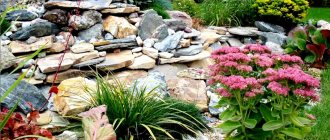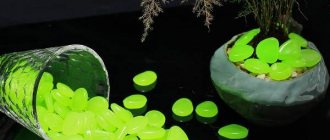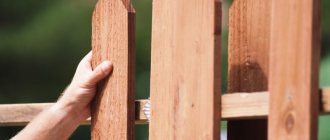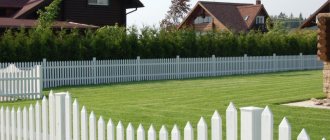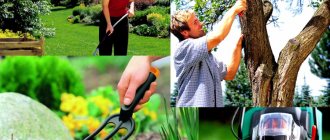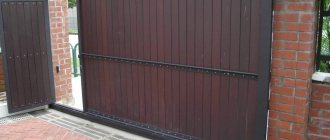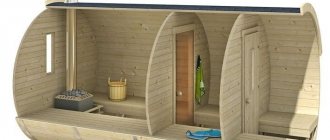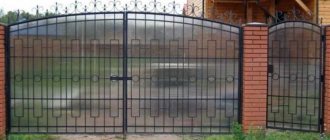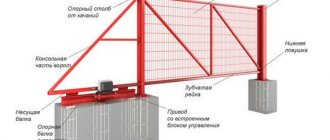Amazing in their originality, undemanding in maintenance, giving scope for imagination - this is a small part of the return that stone gardens on the site can bring. Their appearance remains attractive all year round, and the planted plants will complement the picture of a well-groomed place. Having worked on the creation once, you will admire the fruits of your labors for many years. Properly selected stones for an alpine slide are the key to the success and durability of your landscape creation.
Basic requirements for stones for alpine slides
The lifespan and quality of their service depend on the characteristics of the breed - each is characterized by different fragility, water permeability, and durability. Some are even harmful to certain plants. Even before building the slide, it is important to make sure that the stones meet the following parameters:
- Harmony. Alpine decor should be combined with the landscape design of the rest of the garden.
- Strength. Any diagram or step-by-step instructions for creating an alpine slide necessarily involves gardening work (planting plants, weeding). The rocks must be strong enough to withstand the impact of tools.
- Compatibility with plants. The chemical composition of the material must be safe for the flora planted on the hill.
- Durability. Stones that absorb moisture well quickly lose their original appearance and are destroyed. This is especially noticeable on porous rocks, which is why they are planted in places with frequent drought.
Rock garden at the dacha site
Remember
- Know the features of stones. Rock characteristics influence soil composition and plant growth. For example, limestone deoxidizes the soil, granite increases acidity, etc. This fact is important when selecting plant components.
- Plan correctly. To draw up a plan, two options are used: a project is made and then the material is purchased/assembled, or the layout is based on the available material.
The mountain corner on the site is a striking element of the landscape. Having an idea of stones and the rules of action, everyone can beautifully make an alpine slide on their own territory.
The best stones for decorating a rock garden
A slide can be built from almost any rock. The choice is limited by only a few factors: structure, impact on the soil, moisture resistance and price. Taking these criteria into account, gardeners make the design of an alpine slide from:
- limestone;
- sandstone;
- granite;
- slate;
- basalt;
- shell rock;
- tuff;
- travertine;
- dolomite;
- bricks
Granite
Granite for alpine hills
Hard, heavy, dense rock. Granite comes in a variety of shades: white, pink, green, blue, black. The boulders are large, so they are combined with small flora - large stones will emphasize the grace of fragile flowers. Plants cannot be planted on granite, so it is used only as decoration. The cost of 1 ton is 4000–6000 rubles.
Main advantages:
- high strength;
- resistant to precipitation and winds;
- the most durable stone for an alpine slide.
Minuses:
- heavy weight;
- difficult to process;
- flowers do not grow on it;
- the risk of soil waterlogging due to the moisture resistance of granite - the site must be equipped with a drainage system;
- acidifies the soil - it is recommended to lay such rock only next to conifers and heathers.
Slate
Slate rock garden
A sedimentary material of clay and quartz common in river basins. Slate is thin, smooth, flattened slabs. The breed comes in white, brown, and gray shades. It harmonizes perfectly with any other stones in the alpine hill. Price per ton is 3000–4000 rubles.
Main advantages:
- versatility;
- strength;
- resistance to moisture, winds;
- availability.
Minuses:
- Not easy to process.
Sandstone
Sandstone in the landscape
A smooth layered rock with a porous structure. Sandstone is found in beige, light red, cream, and brown shades. Its neutral chemical composition suits most plants. The breed is used not only as decoration in the garden, but also as a substrate for small flowers. Cost – 3500 rubles per ton.
Main advantages:
- suitable for growing flora on it;
- easy to process both with your own hands and with wind and rain;
- distributed in nature.
Minuses:
- It is short-lived due to its ability to quickly absorb moisture and retain it for a long time.
Limestone
Limestone rockery
A soft, spongy rock with a layered structure. The color range ranges from creamy gray to red. Limestones come in beige, bluish, and golden tints. There are even finds with “drawings” of prints of ancient animals or plants.
The stone gradually weathers, its sharp corners are smoothed out. Due to its porous structure and moisture capacity, it is popular as a flower slide. Additionally, the limestone will be decorated with moss and lichens, which quickly begin to grow in its recesses. Price – 3000–4000 rubles/ton.
Main advantages:
- easy;
- suitable for growing small flora on it;
- the size and shape can be easily changed with your own hands;
- distributed in nature.
Minuses:
- alkalizes soils with high acidity;
- incompatible with plants that need acidic soils (heather, rhododendron);
- brittle;
- short-lived.
Basalt
Basalt for alpine hills
A rock of volcanic origin. The structure is dense, but porous basalt covered with tonsils is also found. The latter, as a rule, are filled with other minerals (quartz, chalcedony). The texture varies from pale gray to black or greenish. The cost of a ton is 5500–6000 rubles.
Main advantages:
- strong;
- resistant to environmental influences (precipitation, wind).
Shell rock
Rockery using shell rock
A smooth, coarse-grained rock, found in brown, sand, cream, and red shades. It is quickly sharpened by wind and rain, and allows water and air to pass through well. The surface of porous shell rock is a favorite environment for moss and lichen. Price – 3500–4500 rubles per ton.
Main advantages:
- a light weight;
- suitable for growing flora on it;
- easy to process with your own hands;
- availability.
Minuses:
- alkalizes soils with high acidity;
- incompatible with plants that need acidic soils (heather, rhododendron);
- fragile;
- short-lived.
Dolomite
Composition with dolomite
Strong, frost-resistant, durable stone. Found in white, gray, yellowish, brown shades. Less common is pink dolomite, as well as transparent and translucent variations. A ton of rock costs between 6,000 and 6,500 rubles.
Main advantages:
- strength;
- durability;
- resistance to precipitation, winds, sub-zero temperatures (does not crack in winter frosts).
Minuses:
- High price.
Brick
Brick for rock garden
Construction (clinker) material, characterized by durability and a variety of shades. Resistant to winds, rain, snow and frost. Decorative brick looks organic next to natural stones. Cost – 2500–3000 rubles/ton.
Main advantages:
- high strength;
- durability.
Minuses:
- Difficult to process.
Rules for combination and placement
- It is recommended to use various types of stones without the use of cement. This will greatly facilitate the work of creating a slide. The height of the structure should reach 0.5-1.5 m.
- All types of stones must be placed harmoniously. The effect of natural exposure of the landscape should be achieved.
It is important that the direction in which the boulders protrude is the same, otherwise it will seem like there are just chaotically scattered stones in front of you. Consider the distance between the pebbles. There should be enough space between it for plants.
- Some people like it when stone elements play a dominant role, while others prefer them to serve only as a background. In practice, the choice of one option or another depends on the quality of the breed.
- Dull rocks can be emphasized with spectacular plants. If you have textured boulders, it is worth emphasizing their beauty. Rocks with inclusions, unusual colors, and chips look good in a hill.
- It is important to choose the right number of stones. If there are not enough of them, smoothing of slopes or sliding of the soil during rain may occur.
- The main elements are flat boulders, on which you can move to take care of the hill and the plants planted on it.
How to choose the right stones
An option for combining stones of different shapes and colors.
An Alpine slide in an apartment or country house should look natural, like a real mountain area. This means that it must be built from stones (natural or artificial) that meet the list of criteria:
- Hue. It is important to maintain a contrast between rocks and vegetation:
- Bright flowers are combined with stones of neutral shades - they act as a dull, nondescript background.
- Inexpressive grasses and bushes are surrounded with bright species - the plants among them look more expressive.
- Glow in the dark stones create a beautiful effect in the evening and at night.
- Breed. The stones must be in harmony with each other, otherwise instead of a hill in the garden you will end up with an absurd pile of cobblestones. The organic structure of a rock garden is a combination of rocks with similar shades and outlines.
- Size. Large boulders are placed at the base of the slide, and small ones are placed closer to the top.
- Form. Stones in an alpine hill look more natural when they are of different sizes and irregular shapes. Priority is given to sophisticated angular shapes, although rounded ones are also useful:
- Sharp blocks or cobblestones will emphasize the beauty of a high slide.
- Flat ones will give the rock garden the appearance of a mountain plateau. They are also used in the creation of the “Czech rolling pin”.
- Smooth, rounded stones are suitable for flat areas or where a stream runs.
- An alpine slide with a pond goes well with sandstone laid out in layers.
- Small pebbles (expanded clay, crushed stone, pebbles) will fill the voids between large boulders.
Video description
The video talks about what other plants can be planted on alpine hills:
You can arrange the plants listed above, but in order for the planted flowers and shrubs not to interfere with each other, it is necessary to use the compatibility method and take into account the shape of the plants, the timing of their flowering, and the color scheme. As mentioned above, there are ready-made kits. Experts recommend purchasing them in specialized stores, where various planting materials are offered: seeds, seedlings, ready-made “adult” plants.
Where to get stones for an alpine slide for free
Types of stones
Suitable material can be found in stores in Moscow and the Moscow region. In addition, stones of different shades, sizes and shapes are common both in nature and in cities:
- On the banks of rivers or other bodies of water, in the mountains.
- Along the sides of roads and railway tracks.
- Decorative stones are often placed on the bottom of aquariums.
- On farms and collective and state farms. Piles of extra stones accumulate here. Owners often give them away just to rid themselves of unnecessary junk.
- Any rocks can be found in the nearest quarry.
- Stones are also found in quarries.
- Suitable specimens can be obtained from construction waste in areas with completed buildings.
- Various stones are scattered in dilapidated or abandoned houses.
River pebbles
Collecting stones on slopes or hills begins from the top point - it is easier to lower them down than to climb with a load. It is better to transport rocks in tarpaulin or bag fabric. This way they rub, shake and hit each other less. It is more convenient to move the found material with a wheelbarrow and a crowbar rather than with your bare hands.
Rocky compositions
Rocky compositions are elegant improvisation, and not always in the alpine style. These arbitrary “companies” meet only your taste and aesthetic needs, just like an essay on a free topic.
Huge boulders are beautiful both on their own and in the company of green grass and brightly flowering perennials.
That is why such an object can be created in almost any corner of the site, both in the sun and in the shade. The choice of stones and plants, as well as the proportion between them, you determine in your own opinion. The only requirement is a harmonious combination. Any trees and shrubs can participate in the composition - both large and short.
Design characteristics
An alpine slide is one of the elements of a dacha or house (Fig. No. 1). They can often be found on the property of friends and neighbors.
To create a slide of stones, you need to plan out all the work. Correct work is performed in several stages:
- 1 Search for an idea.
- 2 Preparing the site for creating a slide.
- 3 Installation of a drainage system at the selected location.
- 4 Selection and placement of stones.
- 5 Selecting suitable plants for the slide.
- 6 Preparing fertile soil and planting plants in it.
All these steps are very important to get good results. Each of them requires some time, especially the third. It can be considered basic. The period during which the slide will be in operation will entirely depend on the quality and correctness of the drainage construction. To build a drainage system, you can use sand and crushed stone left after building a house, small stones and debris.
Soil for plants is laid with careful compaction of the base, otherwise the slide will soon completely lose its shape. Peat, clay, and fine gravel are added to the soil. Plants chosen are unpretentious. They grow in wild forest conditions. These can be low-growing coniferous shrubs, winter-blooming plants, and mosses.
Careers
Active or abandoned mines and quarries are a real Klondike for a person suffering from “stone fever”. Moreover, it is still unknown which type of quarry is better. On the one hand, an abandoned stone or sand mining site provides unlimited opportunities for a tireless adventurer, but on the other hand, independent exploration of “abandoned sites” can be dangerous.
And not only because of the threat of a collapse, but because hardly anyone can give you a guarantee that there are no chemicals left on the rock that were used during the development process.
When dealing with an active quarry, you will still have to part with a certain amount of money. However, at the same time you will be sure of the purity of the material. Don’t forget that the amount paid will in any case be less than what you would have to spend at a garden center.
Recommendations from experts
Various kinds of flower beds in the garden have long become commonplace. Currently, alpine slides are becoming increasingly popular. This is a relatively new building. If done correctly, it will decorate the area for many years.
To create it you need to prepare several stones.
Stones for an alpine slide can be taken from different types or combined. Stones can be painted in any color. After installation and filling of fertile soil, flower, coniferous or herbaceous plants are planted. It is very good to create a small fountain or stream. Then, along with beauty, additional coolness will come.
The original decoration of the garden is an alpine slide. For its production, building grade stones and various plants are used. An alpine slide is also combined with a miniature fountain or waterfall.

